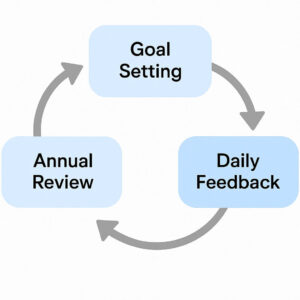Performance Management 101: Why It Matters & How to Structure It in the Workplace
Introduction
Have you ever wondered why some companies grow fast and others struggle for years?
One big secret is performance management.
If you’re running a business or planning to work abroad in places like Nigeria, US, UK, Canada, understanding performance management can set you apart.
Today, let’s break it down together in simple, clear English.
What is performance management and why is it important for an organization?
Performance management is simply how a company helps its employees do their best work.
It’s not just about checking boxes or doing yearly appraisals. It’s about guiding people every day to be better, smarter, and faster.
Here’s why it matters:
- Better productivity: Employees know exactly what is expected.
- Higher job satisfaction: People love working where they feel supported.
- Stronger business growth: When individuals win, the company wins too.
According to a Gallup study, businesses with engaged employees outperform those without by 21% in profitability!
How do you structure a performance management system?

Setting up a strong performance management system is like building a good house, so you need a good foundation.
Here’s a simple guide you can follow:
| Step | What to Do |
| 1 | Set clear, measurable goals for employees (using SMART goals). |
| 2 | Communicate openly: let everyone know expectations and priorities. |
| 3 | Provide regular feedback, not just during yearly reviews. |
| 4 | Offer development opportunities such as training, mentorship, etc. |
| 5 | Review and adjust the system as needed; stay flexible. |
Do you need help with setting up a performance management structure? Kindly fill out this evaluation form so we know how to help you.
What are the 5 elements of performance management?
When I first learnt about this, it made everything click for me. These 5 elements are the real backbone of performance management in the workplace:
- Planning — Set goals and define responsibilities.
- Monitoring — Track progress regularly.
- Developing — Help employees grow their skills.
- Rating — Evaluate and rate their performance fairly.
- Rewarding — Recognize and celebrate good work.
A good system touches all these points, not just one or two.
What are the 3 Ps of performance management?
Another simple way I like to remember performance management is through the “3 Ps”:
- Process: The steps you take to manage performance.
- People: The employees, managers, and leaders involved.
- Purpose: The reason behind all your efforts to drive success.
If you miss any “P,” things can quickly fall apart.
Conclusion
At the end of the day, performance management is about helping people succeed, and when people succeed, businesses grow.
Whether you dream of starting a business in Nigeria or building your career in the UK, US, or Canada, mastering these basics will give you a serious edge.
If you found this helpful, don’t keep it to yourself. Share it with someone today or drop a comment telling me what part you’ll start working on first!
Are you ready to create a winning performance system? Let’s start by evaluating if your team needs it.
Kindly fill this evaluation form (here) to take the right steps.



